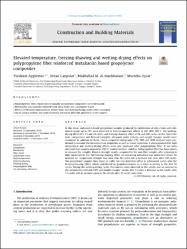Elevated temperature, freezing-thawing and wetting-drying effects on polypropylene fiber reinforced metakaolin based geopolymer composites
Abstract
In this study, metakaolin-based geopolymer samples produced by substitution of silica fume and colemanite waste up to 20% were subjected to high-temperature effects at 300, 600, 900 C, the wettingdrying effect of 5, 15 and 25 cycles and freezing-thawing effect of 56 and 300 cycles. At the end of the
tests, compressive and flexural strengths, ultrasonic pulse velocity and weight changes’ results were
examined. In addition to these, micro-computed tomography (CT), XRD and SEM analyses were performed to examine the microstructure properties as well as visual inspection. 5 series produced for high
temperature and wetting-drying effects were also produced with polypropylene fiber. It has been
observed that samples exposed to 900 C maintained their stability. Polypropylene fiber has been shown
to increase the samples’ flexural strength results compared to the non-fiber samples after exposing to
high temperatures. For the freezing-thawing effect, air-entraining admixture was added to 5 series. An
increase for compressive strength was seen after 56 cycles but a decrease was seen after 300 cycles.
The geopolymer samples thus began to suffer the real distortion effect in subsequent cycles after the
freezing-thawing effect, which contributed to geopolimerization in a sense occurring in the first 56
cycles. During the wetting-drying cycles, fluctuations were observed in the results and an increase in
the compressive strength, UPV and weight changes’ results after 5 cycles, a decrease in the results after
15 cycles and an increase again in the results after 25 cycles were seen.
Volume
235Collections
The following license files are associated with this item:


















